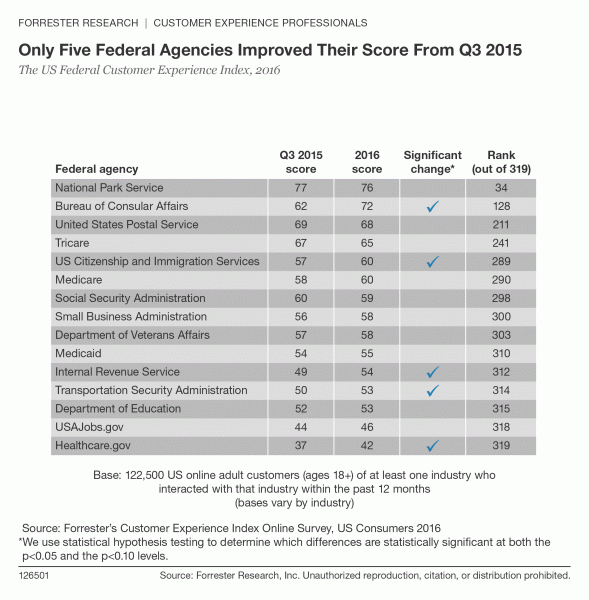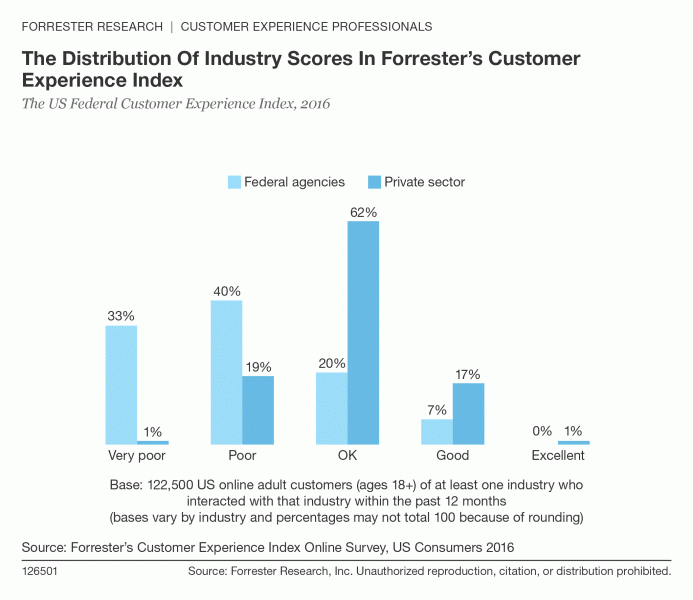Washington Still Fails At CX: Insights From The US Federal CX Index, 2016
The White House requires federal agencies to provide customer experiences that match the best of the private sector's. Yet despite another year of intense focus the federal customer experience remains overwhelmingly weak and uneven.
The 15 US federal agencies and programs that we rated in this year’s US Federal Customer Experience Index (CX Index™) earned an average score of 58, which is near the bottom of the poor category and well below the private-sector average of 70 (see Figure 1). Two-thirds of federal scores stayed flat from 2015 to 2016; even several agencies that worked hard on CX failed to improve.

The situation looks even bleaker when we compare it with the customer experience at the 300-plus companies in 20 private-sector industries in the complete US CX Index. Our results show that Washington has:
- Scores that are mostly poor or very poor. Three-fourths of federal agencies had scores that fell into the lowest two categories of the CX Index (see Figure 2). That's in sharp contrast to the private sector, where only 19% of brands were rated poor and just 1% of brands were rated very poor.
- A near monopoly on the worst experiences. Five out of the eight organizations in the very poor category — and six of the worst 10 in the entire US CX Index — were federal agencies. Only internet service providers, TV service providers, and airlines came close to matching this level of underperformance.

The reason for this stagnation is simple: Federal agencies fail to focus their efforts on the most important drivers of great customer experiences. We tested 40 CX drivers and found that on average, federal agencies:
- Ignore emotion, which has the biggest impact on federal CX. The documents that govern federal CX ignore emotion and urge agencies to boost the ease and effectiveness of their customer experiences. However, the CX Index proves that emotion has a bigger influence on federal CX than effectiveness or ease.
- Obsess over technologies instead of employees. Federal agencies focus far more on technology than they do on empowering employees and getting personal interactions right. But the 10 most important drivers of great federal CX centered on the attitude and behavior of customer-facing personnel. In contrast, most drivers that focused on customer-facing technologies like websites and mobile apps appeared among the less influential half of all drivers.
- Focus on what customers say that they want rather than what really drives better CX. Most federal agencies survey customers about what they want or how they liked an interaction rather than tracking how customers actually behaved as a result of different experiences. Unfortunately, federal customers don't consciously know what makes an experience better for them: Over 80% of the time, the drivers that customers claimed were important to federal CX turned out not to be.
Federal agencies that want to improve their CX quickly and efficiently must ground their efforts in driver analysis and prioritize parts of the experience that will contribute the most to mission success. The CX Index can help because it's more than just a score: It's a framework that measures how agencies perform on 40 drivers of CX and pinpoints the handful of drivers that, when improved, will boost mission performance the most.
To learn more about the specific drivers of a great customer experience for your agency and how Forrester can help your agency reap the benefits of this insight, send an email with your questions to customerexperience@forrester.com.
